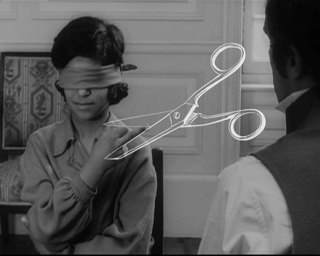Online videos were digitized with the support of the Regional Council of Nord / Pas-de-Calais and digitization plans 2009 and 2010 of the french Ministry of Culture. |


BEAUTIFUL LANGUAGE (THE)
of FATMI Mounir
FRANCE, 2010, 00:16:30
Production : FATMI Mounir
Genre : Video art
Keyword : Language, Memory, Perception, Relation
Summary :
Awarded by the Prize of the Cairo Biennial in 2011.
The beautiful language is rich in text and images, but it is hard to read. The cut-up technique, popularised in William Burroughs' texts is applied here to the images, with fragments of fraught exchanges appearing in a non-linear fashion. The images are taken from L'enfant sauvage (“The Wild Child”), François Truffaut's 1970 film, based on the true story, from the end of the 18th century, of an “uncivilised” boy being taken in by a doctor and studied as a specimen of difference. The images chosen for The beautiful language show the child being measured, taught and tested.
The film opens with images of the unkempt child having his face cleaned and his hair cut. The image is uncomfortable, the child unwilling to consent to this treatment – we see him screaming, although the sound is silenced and replaced by an ominous soundtrack.
This disturbing image is followed by the statement: “My tongue is a haemorrhage, I bleed each time I speak”. These violent words set the tone for a video which provokes questions about the very nature of language as a tool for both communication and repression. It also highlights the role of language in shaping society and peoples. The disjunction between English statements, Arabic words and images of French words in the video highlight the ambiguities of language and the room left for interpretation and miscommunication. The arabic words also place the western viewer in the position of the outsider, the “savage”.
Not only is this a reference to early anthropological ideas about otherness and the way the “savage” mind understands words and graphic representations, it is also a metaphor for France's interest in the “other” during the Imperial era. The doctor's incessant note-taking represents attempts to control and the implicit violence suggests the violence of imposed authorities. Again language plays a crucial role in trying to unify doctor and subject, or colonisers and colonised.
Truffaut's images of the doctor's bourgeois interior are alternated in a rapid montage mixed with slow motion and other destabilising effects. The more violent episodes of the film are used to contrast images of the child in the wilderness and the child becoming “civilised”. Seeing the naked boy in the forest on all fours compared with being forced to wear shoes in a bourgeois interior, or writhing on the floor in an attempt to escape this forced education, raises questions as to where the real savagery lies: in the wild or in the stringent surroundings of modern societal norms?
By introducing thought-provoking statements to these images, mounir fatmi brings the original story to bear on contemporary society, bringing into focus the thin line between brutality and civilisation. The final part of the video is entitled “The straight line” and shows the doctor drawing a straight line for the child to copy. The image of the child trying to copy the straight line is cut with an image of the child scribbling a large, uneven spiral. On one hand he can be seen as reverting to his unsophisticated roots; on the other this scene can be seen to represent the unnatural way people are channelled into the strict lines to conform with society's expectations and demands.
“Deadly danger to any civilisation is no longer likely to come from without”, the video states. The eighteenth and nineteenth century legacy of attempting to control has led to a contemporary global civilisation under extreme stress, due not least to “forcing millions of people into conditions which, despite all appearances, are the conditions of savages”. The beautiful language thus explores early reactions to difference and their relationship to contemporary society, with its underlying problems of racism, difference and terrorism.
Caroline Rossiter
Original language : _wordless
Original format : video
Aspect ratio : 4/3
Chroma : Noir&Blanc
Available version(s) : Sans paroles.











